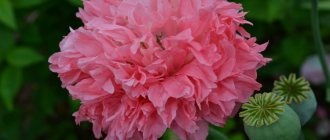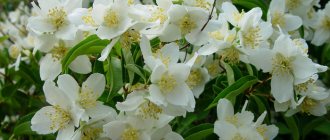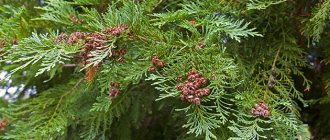Rosemary or rosmarinus belongs to a genus of perennial evergreen shrubs, common in Europe and the Mediterranean, Crimea, and Asia.
This plant is green in color with sharp needle-like leaves, the smell is reminiscent of a mixture of eucalyptus, camphor, pine and citrus. In nature, rosemary grows up to two meters. It cannot withstand frost; temperatures below +11 degrees Celsius are destructive for it. During flowering, the plant opens, it is strewn with flowers of lilac, sky blue and white, and the air is filled with a fragrant aroma.
Rosemary plant description
Rosemary is a perennial, evergreen plant belonging to the Lamiaceae family. This family also includes: sage, marjoram, thyme, oregano, basil, savory, lemon balm, mint and motherwort.
Close relatives of the spicy plant are such little-known representatives of the flora with “talking” names as: nutwing, bristletail, beautiful fruit, snakehead, catnip, ziziphora and odorous.
Rosemary is not an herb; it is a branched subshrub with blue flowers and small evergreen needle-like leaves.
The height of the plant can vary from 50 to 200 centimeters. The root system of the subshrub is very powerful and goes deep into the ground up to 4 meters.
The plant forms numerous branches. Old shoots harden over time, becoming olive-brown bark. And young ones remain green for a long period.
Rosemary leaves are narrow, leathery, grow densely and reach a length of 1.5-4 centimeters. They are slightly shiny above and slightly pubescent below. The leaves are linear in shape, thick, saturated with moisture, slightly curved at the edges and at the end. In general, they are very similar to spruce needles.
Rosemary has many positive properties. It is used not only as a spice for cooking and medicines, but also as an ornamental plant and landscape element.
The herbaceous minty aroma of rosemary will enchant anyone. Therefore, its oil is used in perfumery, pharmacology and phytocosmetology. Rosemary tastes slightly spicy and bitter. It is an indispensable ingredient in a mixture of Provencal herbs.
You can see what rosemary looks like in the photo below.
Use in cooking
In cooking, this plant is used as a spicy seasoning for various meat dishes. The main thing is that it does not lose its aroma and its beneficial properties during heat treatment. It has a strong camphor aroma with a perceptible pine scent. The taste of the spice is a little spicy. Also used as an additive to tea, flour products and in marinades. The spice gives soft and alcoholic drinks a special pleasant taste. Goes great with mushrooms and vegetables. Included in the famous Herbes de Provence seasoning.
Origin
The western part of the Mediterranean coast is considered the homeland of this unusual shrub. Rosemary is famous for its centuries-old history.
Historical facts
Translated from Latin, rosemary means “sea freshness”. The ancient Romans believed that the coastal sea wave gives the most delicate shade to flowers. This is where the name came from. People called this spice “incense herb”, “wedding flower” and “bride’s dress”.
- In ancient Greece, Egypt and Rome, rosemary was considered sacred.
- The ancient Greeks presented bouquets of rosemary as gifts to their goddess of love, Aphrodite. And in the Middle Ages, a bouquet of flowering plants was presented as a gift as a sign of prosperity and good luck. In some countries this tradition has been preserved to this day.
According to Christian legend: its white inflorescences acquired a delicate blue color when the Virgin Mary placed her cloak on the branches of the subshrub to hide little Jesus from the sun.
- The Egyptians placed blooming rosemary in the palms of the dead in order to brighten their path to the world of shadows with the aroma of freshness.
- The beauties of Hellas used this plant to care for their beautiful hair and delicate skin.
- The ancient Romans fumigated rooms with terminally ill people with rosemary and believed that the fresh smell warded off disease, death and evil.
- The Romans wove beautiful wreaths from plant branches and decorated themselves and their loved ones with them. It was the Romans who introduced Europe to this wonderful spice.
- The Hungarian Queen Erzsebet made a rejuvenating tonic from rosemary, which is why she was able to maintain her youth until she was 70 years old and seduce the Polish king.
- The flowers of the spice plant are a symbol of fidelity and eternal memory. They are often added to brides' wedding bouquets.
- In Turkey on the Gallipoli Peninsula, rosemary grew in large quantities and it was there that more than ten thousand Australian and New Zealand soldiers died during the First World War. Now in these countries on April 25, on the national holiday Anzac Day, those killed in military conflicts are remembered. On this day, veterans pin a branch of rosemary to their clothes.
- During World War II in France, hospitals burned rosemary leaves and juniper berries to protect against germs.
Historical facts
For the first time, rosemary, like many other medicinal or spicy plants, became known in Ancient Egypt, Rome and Greece. It was also one of many sacred plants. It was very often used in various historical or religious rituals; with its help, evil spirits were expelled from homes. It was believed that the Greek gods decorated themselves with wreaths of blooming rosemary and simply adored this plant. That is why the Greeks very often did the same thing: they wove wreaths from a flowering plant or its greenery and decorated their heads with them. This was especially popular among philosophers and writers: it was believed that such a wreath could refresh the mind and inspire new ideas.
In addition, it is considered a symbol of prosperity and abundance, so it is very often used to attract good luck and is given to newlyweds so that the family is strong and the house is full.
The Greeks considered rosemary to be a plant of Venus, since, in their opinion, it was able to make a person happy, cheerful and carefree, as well as inspire deeds of love. In addition, it was used as a remedy against bad dreams and to prolong the freshness of youth of the soul and body.
Rosemary was a must-have plant in the home of a person who was ill, as it was believed to tonify the body. For the sake of preventing various diseases, it has become a mandatory attribute of large gatherings of people, for example during holidays or public processions. This opinion is absolutely fair, because rosemary contains substances that prevent the development of pathogenic bacteria in the body.
Where does rosemary grow?
Rosemary grows uncultivated in Europe, North Africa, Greece, Spain, Portugal and Cyprus.
The wild subshrub is not found in Russia. Here it is grown as a cultivated plant. Gardeners plant it in pots, and on summer days they take it out into the open air and leave it in a well-lit place. In Russia, it is grown in Crimea.
Rosemary is also cultivated on a factory scale on rosemary plantations:
- The plant is rich in esters and is famous for its unique properties. To produce essential oil, the tops of young stems are cut off along with flowers and leaves during the flowering period.
- To use rosemary as a seasoning, young branches are collected before flowering throughout the summer. The collected shoots are dried in the shade under a roof or awning and then ground. Or supplied fresh. In the form of a dry seasoning, it can be stored for 2-3 years.
Rosemary recipes for treatment and prevention
An infusion of leaves helps with various respiratory diseases. To do this, you need to take it orally 3-4 times a day. It is no less useful during a cold: you can use it to improve your condition if you gargle or use it to rinse your nose.
An infusion of dried rosemary is often used as an effective remedy for flatulence and various problems with the gastrointestinal tract. In addition, doctors recommend taking a weak infusion to people who have suffered a stroke, as this plant can restore blood circulation in the brain.
Rosemary decoction
Take two teaspoons of dried leaves, add 250 ml of boiling water to them and boil the resulting mixture for 15-20 minutes. Then let cool slightly and strain thoroughly. The resulting mixture should be consumed one teaspoon half an hour before meals.
Alcohol tincture
For 250 ml of vodka or diluted alcohol you need to take 20 grams of dried leaves, infuse the resulting mixture in a dark, cool place for 10 days, stirring occasionally. Then strain thoroughly and store in a dark place. Drink 25 drops 3 times a day half an hour before meals, adding to a small amount of water.
Rosemary infusion
Add 2 teaspoons of crushed raw materials to 250 ml of boiling water, leave for half an hour and strain thoroughly. The resulting mixture must be drunk in one day, in about 5 doses.
Rosemary tea
To do this, add about one teaspoon of dry rosemary to one mug of boiling water and let it brew thoroughly. This tea will help with weakness, stress or after illness. A few glasses a day are enough to make you feel much better and more energetic.
How rosemary blooms, features and life expectancy
The shrub blooms from April to July. In Israel, flowering can continue until November. The fruits ripen in September. The fruit resembles a nut: it is ovoid, smooth, and brown in color.
In summer, blue-violet inflorescences can be observed on the plant, which are slightly pubescent on the outside. The upper lip is notched, the lower is slightly longer than the upper.
Wild rosemary lives for 10-15 years, and at home it pleases the eye for 20-30 years.
It is unpretentious to the soil; it can grow even in rocky soil. But the bush does not tolerate excessive moisture in the ground. As a result, he dies or develops poorly. The structure of rosemary leaves helps it store moisture and thus withstand the summer heat.
And he certainly loves warm and arid climates, as he grows in open areas in the full sun. It does not tolerate cold weather, so its peak flowering occurs in the summer months.
Diseases and pests
If you are not careful, diseases may occur:
- white powdery mildew on the leaves of the stems - infection with powdery mildew (sharply cut off the damaged parts; replace the top layer of the substrate; spray with a fungicide or dip in a fungicide solution; then adjust watering and ventilation, put in a brighter place);
- brown leaves in winter - improper watering, mold, insufficient lighting (change the substrate, remove damaged parts, adjust watering, move to a brighter place).
Rosemary is a natural insecticide, so insects avoid it. However, it can sometimes be damaged by scabies mites and spiders. Industrial insecticides are used against them.
Types of rosemary
The subshrub has many varieties, but only 2 of them are the main types of rosemary and have a wide range of uses.
Common rosemary
It is the only species grown as a cultivated plant for culinary and pharmacological purposes. The species is distinguished by its unpretentiousness. It easily takes root both at home and in the garden.
Its foliage is lighter than other varieties. The inflorescences are closely adjacent to each other. Its flowers are of delicate shades: white, purple, pink and lilac.
Rosemary prostrate
Most often it can be found in southern latitudes. The bush has a spherical shape and reaches a height of 50-70 centimeters. Young leaves are thin, bright green. Old leaves are denser with a green-blue tint. In everyday life, it is mainly used for design and decorative purposes.
Useful properties of the plant
The distinct smell and taste of the shrub is given by essential oils, which are found in abundance in the leaves, shoots, and even in the flowers themselves. Surely many cosmetologists have heard about the beneficial properties of rosemary oil. In addition, the leaves of the bush contain rosmarinic and ursolic acids, alkaloids and tannins, antioxidants, and contain phosphorus, potassium, magnesium, even sodium and iron.
Vitamins include carotene (A), ascorbic acid, vitamin B. The essential oil itself is rich in alpha-pinene and camphene, contains L-camphor, borneol (all these elements are used to obtain camphor) and other useful substances.
The beneficial properties of rosemary include:
- improved digestion (increases the secretion of gastric juice);
- has a tonic effect;
- has choleretic properties;
- increases heart rate and blood pressure;
- can relieve pain in the heart and stomach;
- cleanses the air well of microorganisms;
- when added to smoking mixtures, it helps with asthma;
- stimulates hair growth on the head;
- has a beneficial effect on the nervous system.
Varieties of rosemary
From rosemary (ordinary rosemary), breeders have been able to develop many different varieties. Rosemary varieties have slight differences in shape, leaf color, color palette, and area of application.
Corsican blue
Most often it is used for medical purposes. The leaves of this variety are grayish-green and have opposite leaf arrangement on the branch. The inflorescences grow in groups. They are small, blue, and have a bright aroma.
Blue winter
This variety is very popular among landscape designers. The shrub is adapted to frosty climates. The needle-shaped leaves are blue-green in color. Rosemary flowers are purple. It exudes a pleasant aroma of eucalyptus and pine needles.
Crimean
It has been growing on the Crimean peninsula since the 19th century. This variety is valued for its medicinal properties. It reaches a height of about one hundred centimeters. Does not tolerate temperature changes, is unpretentious to the soil and loves heat very much. Its leaves are dense blue-green. The flowers are white and purple.
Tenderness
This is one of the most popular varieties in Russia. He loves warm climates and bright sun. The height of the bush is about 90 centimeters. The leaves are usually green, but in September, when the fruit is formed, they darken and turn blue-green. They are thin, no more than 3 centimeters long. Flowers are blue.
Dewdrop
This variety of rosemary is widely used in cooking. Its leaves are dark green, very elongated, located tightly to each other, similar to spruce needles. They contain a large amount of essential oils that exude a mixed aroma of sea and lavender. The flowers are bluish-violet.
White
This variety is very rare. It is used for medicinal, culinary and decorative purposes. During flowering, the shoots reach 50-100 centimeters. Its leaves are bright green.
Ampelny
The variety is popular among landscape designers. It is thermophilic and rarely found in the wild, as the plant requires care. Its grown shoots twist and hang down bizarrely. It has bright green leaves and delicate purple flowers.
Caring for rosemary at home. Details
Like all living organisms, it has its own preferences and whims. Having decided to grow shrubs at home, you need to get to know them better.
Bloom
rosemary blooms . In the axils of thin, small leaves resembling spruce needles, two-lipped small flowers are formed.
They are attached to the shoots by short petioles. The color of the flowers can be different: purple, white, blue, lilac or pink. It depends on the plant variety. The flowers of indoor rosemary, like the leaves and shoots, contain essential oils that give them a noble aroma of sea freshness and vigor. After flowering ends, a small fruit with tiny seeds is formed.
Temperature
The plant is thermophilic. Therefore, when growing homemade rosemary, it is important to maintain temperature conditions. In summer, the bush is comfortable when the mercury does not rise above + 25 °C. In winter, the plant is kept at + 16°C (the main thing is that it should not be lower than + 8°C).
Reacts poorly to sudden changes in temperature and drafts. When ventilating the room, remove the container with the bush from the window.
Spraying
Drought-resistant shrub that grows well at average air humidity. It does not tolerate low humidity well: it quickly turns yellow and dries out. Frequent spraying of rosemary is not required.
Sprayed on hot dry days and shaded from the aggressive rays of the sun. A pot with a bush is placed on a tray with wet pebbles, and an open container with water is placed next to it.
Lighting
It is fundamentally important to choose the right lighting for the plant: only then will it develop well. The shrub is photophilous. It should be placed in the brightest place - on a southwestern or southern window. The shrub is very responsive to bright light.
With sufficient lighting, when the plant is in direct sunlight for 6 - 7 hours a day, it will grow, its greenery will be evenly and juicy colored. But in the hottest time it is shaded. To ensure that the crown is beautiful and develops evenly, the pot with the flower is periodically turned, exposing first one or the other side to the light.
In winter, the backlight is turned on for 10–12 hours daily. Lack of light is detrimental to rosemary.
Watering
It is important to water correctly.
Carefully ensure that there is no stagnation of moisture in the soil and that a crust does not form on the substrate. In summer, watering rosemary should be frequent and abundant. In winter, water rarely and sparingly, up to three times a month, when the top layer of soil begins to dry out. To avoid stagnation of moisture, create good drainage and use loose soil.
Pot
The plant has a powerful rhizome. The rosemary pot should be spacious enough to accommodate the roots comfortably and have enough space for a drainage layer. But too large a container is not needed: the space will promote the development of root rot. Drainage holes are needed at the bottom of the pot to allow excess moisture to drain out.
Many gardeners advise planting rosemary in a clay pot so that the roots can breathe. But when choosing a clay pot, you need to be prepared for the fact that you will have to water the plant more often.
Priming
In order for the plant to develop harmoniously, it is important to choose the right soil. For rosemary indoors, select a well-drained and nutritious substrate. This can be either a universal flower soil mixture purchased in a store or soil prepared with your own hands.
To make your own substrate, take turf and leaf soil, sand and peat in equal proportions. Vermiculite, brick chips, sphagnum particles and coal powder are added to the soil.
Feeding and fertilizer
Rosemary is responsive to fertilizers: they help the bush become thicker and stronger. Twice a month, the plant is fed and fertilized with a liquid mineral product for home flowers, diluted with water. It loves calcium, so when choosing a fertilizer, you should prefer one containing this element.
Sometimes, to water the rosemary plant at home, add soda to the water (you need to take soda on the tip of a knife for a liter of water).
The bush is fed after watering, then shaded for a day. You cannot fertilize in winter.
Transfer
Rosemary is transplanted in the spring.
Young bushes are replanted every year, adults - every 3.5 years. The top layer of the substrate is replaced every year: the plant quickly consumes nutrients from the soil. Replanting is a convenient opportunity to replace the pot, soil and improve drainage. They begin to fertilize the plant after 21 days.
Trimming
When rosemary shoots become bare at the beginning of spring, rejuvenating pruning is carried out. To do this, remove branches growing at soil level. In the first half of June, formative pruning is carried out to give the bush a beautiful completed shape. Trimmed shoots can be rooted or used for food.
Rest period
At the beginning of November, the plant's dormant period begins. The pot with the bush is moved to a cool place. Watering is reduced, but the soil is not allowed to dry out. The plant is no longer fertilized. At the end of February, rosemary begins to emerge from hibernation. Gradually accustom them to light and increase the number of waterings. Feeding is resumed.
Contraindications to the use of spices
The seasoning has contraindications for use:
- Hypertension. It has a stimulating effect on muscle tone, which leads to pressure surges.
- Epilepsy. May provoke seizures due to stimulant effects.
- Age up to 5 years. Possible sleep disturbances, insomnia and increased excitability.
During pregnancy, excessive intake can contribute to miscarriages by increasing uterine tone.
When breastfeeding, the seasoning is contraindicated - it stops lactation and can cause convulsions in the child.
Watch Elena Malysheva’s program about the benefits of seasoning:
Sources
- https://RasteniyaDom.ru/komnatnye-rasteniya/rozmarin.html
- https://NarodZdorov.ru/lekarstvennye-rasteniya/rozmarin.html
- https://elki-zelenye.ru/rozmarin
- https://SpicePortal.ru/spetsii-i-pryanosti/aromatnyj-rozmarin-vidy-sorta-opisanie-rasteniya-istoriya-proishozhdeniya
- https://rastenievod.com/rozmarin.html
- https://komnatnie-rastenija.ru/rozmarin-vyrashhivanie-i-uhod-v-domashnih-uslovijah-foto-vidov/
- https://pripravit.ru/opisanie/rozmarin
[collapse]
Characteristics of culture
The cultivation of aromatic plants from the genus Rosemary (Rosmarinus), belonging to the family Lamiaceae, began more than 2000 years ago. Nowadays, its varieties are grown as an essential oil crop used in perfumery, cosmetology, and the food industry. In the southern regions these are evergreen perennial plants, in the middle and northern latitudes - annual plants in open ground and perennials as a potted crop.
Information!
There is no single version of the origin of the name. According to one assumption, the word “rosmarinus” has Greek roots and consists of the words “rhoyps” + “meron”, which means “shrub” + “balm”, according to another version the word is Latin and originates from “ros marinus” - sea dew . Pliny believed that rosemary flowers are colored blue by sea water falling on the plant with splashes from the surf.
In nature, varieties of rosemary are represented by evergreen branched shrubs (height from 0.5 to 2 m) with a powerful root system penetrating to a depth of 3-4 m. The tetrahedral stems are woody, dark gray, the bark peels off, in annual plants the stem is light gray color, slightly pubescent.
The leaf blade is narrow (2-4 mm), long (15-35 mm), similar to a fleshy needle with a blunt tip and downward-curved edges. The sessile leaves are opposite, their surface is leathery, smooth, there is slight pubescence below, the pulp contains a large amount of essential oils with eucalyptus, camphor, lemon and pine notes in the aroma.
Small two-lipped flowers (5-10 pieces) of white, light or dark purple color form a false raceme. Flowering begins in May and lasts 1-1.5 months, and in some regions until autumn. Seed ripening occurs in September-October.
The heat-loving and moisture-loving culture prefers areas with slight partial shade, loose and nutritious soil, does not like full shade and places completely exposed to the sun; when moisture stagnates, the roots rot. In winter, at subzero temperatures, the root system dies even under cover, so in a temperate climate the plant is transplanted into a pot and brought into a heated greenhouse. The maximum amount of oils accumulates in the aerial part by the age of three.
Harm and contraindications
A medicinal herb in the right doses is extremely beneficial, but sometimes rosemary can cause harm to the body. This occurs if there are some contraindications:
- pregnancy (rosemary provokes uterine contractions, which can lead to premature birth or miscarriage);
- breastfeeding (the plant is allergenic and therefore dangerous for babies);
- history of hypertension and cardiovascular pathologies;
- epilepsy;
- nervous and psychosomatic disorders;
- convulsive syndrome;
- obesity (fatty acids provoke weight gain);
- children's age (up to three years).
Since rosemary is allergenic, it is not recommended for people with intolerance to various seasonings, spices, citrus fruits, tea, and medicinal herbs. The essential oil of the plant should not be consumed in its pure form.
For treatment, it is necessary to prepare decoctions, teas, and, in rare cases, alcohol tinctures. In order not to burden the kidneys and provoke inflammatory processes, you should not abuse rosemary-based products. It is necessary to follow the norm and use medicinal herbs only after a visit to the doctor. In this case, the use of rosemary will be extremely beneficial.











